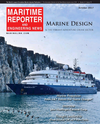
Page 75: of Maritime Reporter Magazine (October 2017)
The Marine Design Annual
Read this page in Pdf, Flash or Html5 edition of October 2017 Maritime Reporter Magazine
3D Printed Propeller
A prototype of the world’s ? rst class approved ship’s propeller manufactured using 3D printing techniques has been produced by a cooperative consortium of companies that includes Damen Ship-
Twi? ex yards Group, Rotterdam Additive Manu- facturing LAB (RAMLAB), Promarin, Au-
The Twi? ex Turning, Locking & Braking todesk and Bureau Veritas.
(TLB) System consolidates three usu-
The 1,350mm diameter propeller – ally separate interfaces and functions named WAAMpeller – was fabricated into one design package.
from a Nickel Aluminium Bronze (NAB) al- loy at RAMLAB in the Port of Rotterdam.
The propeller was produced with the
Wire Arc Additive Manufacturing (WAAM) method using a Valk welding system and
Turning, Locking
Autodesk software. The triple-blade struc- ture uses a Promarin design that is used
Braking System on Damen’s Stan Tug 1606. With produc-
During the operational life of a ship or tion complete, the WAAMpeller will be ocean going vessel, regular maintenance
CNC milled at Autodesk’s Advanced Man- of the propulsion shaft and propeller is re- ufacturing Facility in Birmingham, U.K.
quired to ensure that all components are
The 400kg prototype 3D printed propel- operating ef? ciently and safely. Part of the
Damen ler represents a steep learning curve of process requires aligning and locking the the understanding of material properties, shaft in place to enable this work to be car- the printed material to ensure compli- 7x2x2 meters, said Wei Ya, Postdoctoral according to Kees Custers, Project Engi- ried out by the ship’s engineers. Twi? ex Ltd. ance to Bureau Veritas standards. “This Researcher from the University of Twente neer in Damen’s R&D department. “This has launched a Turning, Locking & Braking involved printing two straightforward walls at RAMLAB, “For large scale 3D metal de- is because 3D printed materials are built (TLB) System that provides a compact solu- of material – then using a milling machine position, the WAAMpeller is really ground- up layer by layer,” Custers explained. “As a tion to allow the shaft position to be set and to produce samples for lab testing of ten- breaking for the maritime industry.” consequence, they display different physi- locked when the vessel is stationary. sile and static strength,” Custers said. This ? rst prototype WAAMpeller will be cal properties in different directions – a
The Twi? ex TLB consolidates three usually “The challenge has been to translate used for display purposes, and planning characteristic known as anisotropy. Steel separate interfaces and functions into one a 3D CAD ? le on a computer into a physi- for a second example is underway. “We design package. The modular TLB system or casted materials, on the other hand, cal product. This is made more complex start production of a second propeller are isotropic – they have the same prop- is con? gured to allow customers to select because this propeller is a double-curved, with class approval later next month – us- erties in all directions.” and install one of the turning, locking and geometric shape with some tricky over- ing all the lessons we have learned over
Because of this critical difference, one braking functions individually or choose hanging sections,” Custers said. the past few months,” Custers noted. “We of the ? rst steps was to carry out exten- paired or complete turning, locking and Highlighting RAMLAB’s capacity to print are aiming to install this second one onto sive testing of the material properties of braking functionality depending on project objects with maximum dimensions of one of our tugs later this year.” requirements. The system was originally commissioned by a manufacturer of ma- rine propulsion systems for a next genera- tion, ice-breaking vessel. The manufacturer wanted a solution which could be easily op- erated to perform multiple functions. Twi? ex
Ltd. was approached because of its exten- sive experience providing braking systems for marine applications. Twi? ex engineers designed and delivered the complete pack- age so that it could be quickly integrated with the rest of the drive train.
The Twi? ex TLB-180 includes a split disc with gear tooth pro? le which is mounted onto a customer supplied ? ange, making the need to disassemble the propulsion shaft unnecessary. An integrated motor driven geared pinion (Turning Gear) engag- es with this disc to provide up to 140 kNm turning torque at 0.6 rpm in either direction.
Two direct, hydraulically applied, spring re- leased caliper brakes acting on the disc provide 180 kNm braking torque and along with a manual locking device, can be used to hold the propulsion shaft.
The Twi? ex TLB is now available with turn- ing torques up to 454 kNm, braking torques up to 862 kNm and a variety of turning speeds. The complete system is supplied with brakes, actuation and locking devices, controls and hydraulics and will be delivered as an engineered product, built in-house to meet speci? c application requirements.
www.marinelink.com 75
MR #10 (74-81).indd 75 MR #10 (74-81).indd 75 10/4/2017 12:06:06 PM10/4/2017 12:06:06 PM

 74
74

 76
76
